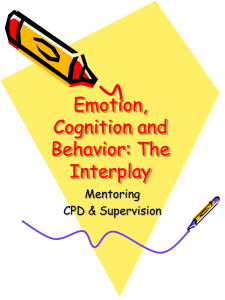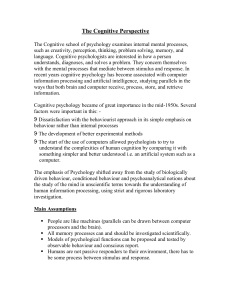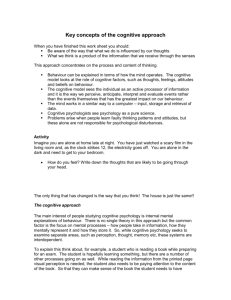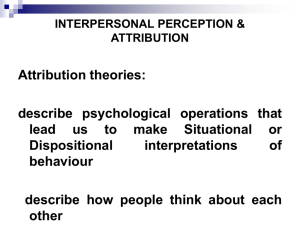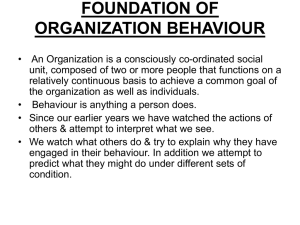Cognitive Approach Model Answers
advertisement
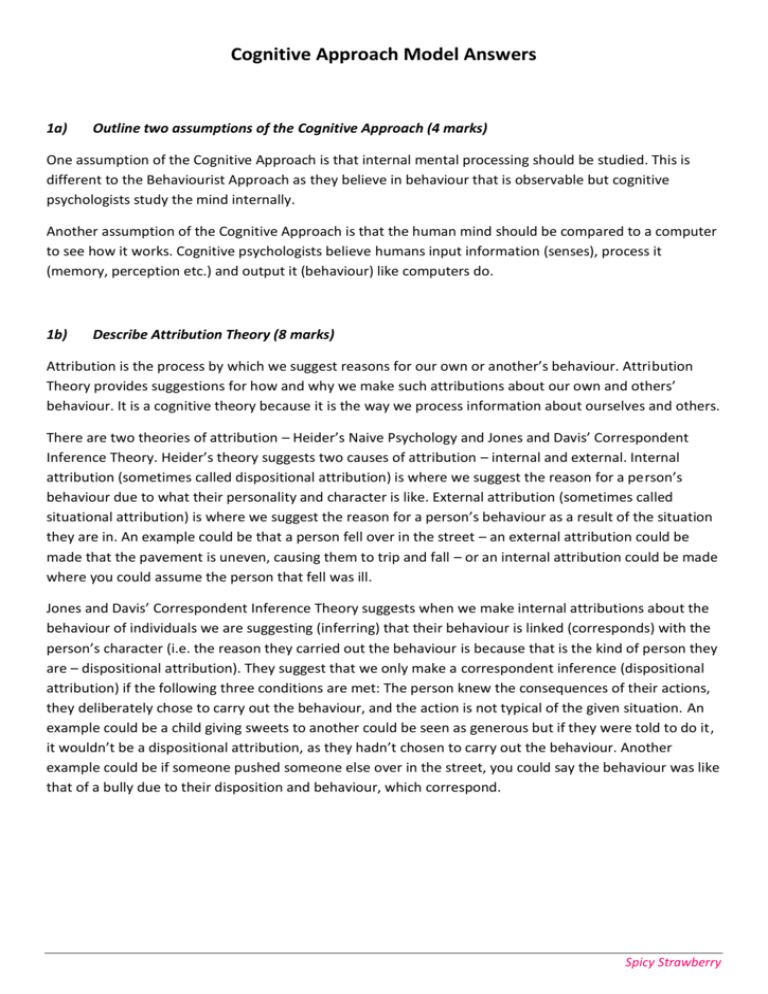
Cognitive Approach Model Answers 1a) Outline two assumptions of the Cognitive Approach (4 marks) One assumption of the Cognitive Approach is that internal mental processing should be studied. This is different to the Behaviourist Approach as they believe in behaviour that is observable but cognitive psychologists study the mind internally. Another assumption of the Cognitive Approach is that the human mind should be compared to a computer to see how it works. Cognitive psychologists believe humans input information (senses), process it (memory, perception etc.) and output it (behaviour) like computers do. 1b) Describe Attribution Theory (8 marks) Attribution is the process by which we suggest reasons for our own or another’s behaviour. Attribution Theory provides suggestions for how and why we make such attributions about our own and others’ behaviour. It is a cognitive theory because it is the way we process information about ourselves and others. There are two theories of attribution – Heider’s Naive Psychology and Jones and Davis’ Correspondent Inference Theory. Heider’s theory suggests two causes of attribution – internal and external. Internal attribution (sometimes called dispositional attribution) is where we suggest the reason for a person’s behaviour due to what their personality and character is like. External attribution (sometimes called situational attribution) is where we suggest the reason for a person’s behaviour as a result of the situation they are in. An example could be that a person fell over in the street – an external attribution could be made that the pavement is uneven, causing them to trip and fall – or an internal attribution could be made where you could assume the person that fell was ill. Jones and Davis’ Correspondent Inference Theory suggests when we make internal attributions about the behaviour of individuals we are suggesting (inferring) that their behaviour is linked (corresponds) with the person’s character (i.e. the reason they carried out the behaviour is because that is the kind of person they are – dispositional attribution). They suggest that we only make a correspondent inference (dispositional attribution) if the following three conditions are met: The person knew the consequences of their actions, they deliberately chose to carry out the behaviour, and the action is not typical of the given situation. An example could be a child giving sweets to another could be seen as generous but if they were told to do it, it wouldn’t be a dispositional attribution, as they hadn’t chosen to carry out the behaviour. Another example could be if someone pushed someone else over in the street, you could say the behaviour was like that of a bully due to their disposition and behaviour, which correspond. Spicy Strawberry 2) Describe how the Cognitive Approach has been applied to either Cognitive Behavioural Therapy or Rational Emotive Therapy (12 marks) The aim of Cognitive Behavioural Therapy (CBT) is to reduce symptoms of depression and turn negative thought processes into positive ones. It links back to the Cognitive Approach as it believes internal mental processing should be studied, and as depression is considered a mental illness, it is internal. Beck’s approach was called reconstructive therapy, and he believed negative thoughts often begin from childhood, and developed the cognitive triad (negative self-schema, negative thoughts about the present and negative thoughts about the future). A negative opinion of themselves (self-schema) could be due to rejection or criticism from parents/peers or any tragic events. These negative thoughts are reactivated when a situation arises similar to one previously that made them feel negative about themselves. For example, a person who was bullied as a child gets bullied in the workplace, reactivating old memories and making them depressed. Beck also said this happens automatically; there is no conscious decision to change thought patterns into negative ones. It causes individuals to misperceive reality and make errors in thinking. Errors in thinking include over-generalisation, where you come to a sweeping conclusion on only a single event, e.g. “I must be stupid because I did badly in class today”. Personalisation is another error in thinking, and this is where an individual assumes responsibility for bad events in the world, e.g. “It’s my fault everyone has the flu”. Magnification and minimisation are the other errors in thinking, and this is where you make a big deal over a small amount of bad events and make nothing of good events, e.g. a man loses £5 and gets very angry and upset but finds £20 later on and feels nothing. CBT challenges negative thinking by using counselling methods involving the individual providing evidence for their reasoning that they are ‘worthless’ or ‘nobody loves them’. This is called hypothesis testing. Clients are given ‘homework’ in the form of tasks to examine their negative thinking, for example if a client is depressed about no one going to the cinema with them, the therapist may ask them to invite a family member along and report back to them how it went at the next therapy session. The third part of CBT is reinforcing new positive ways of thinking and reflecting on results to identify any changes in their way of thinking due to their new outlook on their life. A supporting study is Cahill et al, who questioned and assessed how bad the symptoms were after clients finished a therapy session. They tested 58 people, and on completion of treatment, 71% of clients showed a significant reduction in the severity of symptoms, showing the effectiveness of CBT. However, there is a debate on whether or not CBT is only favoured by clinicians as it is relatively cheap compared to psychodynamic therapy, for example, rather than it being effective. The client must also be motivated to change their outlook otherwise the therapy is of very little use. Spicy Strawberry 3a) Evaluate two strengths of the Cognitive Approach (6 marks) One strength of the Cognitive Approach (CA) is the practical application of Cognitive Behavioural Therapy (CBT) which aims to challenge negative thinking to change thought patterns into positive ones. Cahill et al tested over 50 clients and 71% reduced their symptoms’ severity, so the therapy has been proven to be effective. It is also fairly cheap to do, as well as being very in-depth, detailed and tailored to each client (idiographic). Another strength of the CA is it uses case studies, scientific experiments and brain scanning techniques to conduct research. Conditions in scientific experiments are controlled, so cause and effect can be established from their tests, and all extraneous variables are controlled so conclusions can be drawn. An example is free recall, where participants must look at and remember words/numbers and recall them. Replication of experiments is easy, e.g. a researcher conducting free recall experiments who followed correct procedure can do the same test again and again to check for consistency of results. 3b) Evaluate two weaknesses of the Cognitive Approach (6 marks) One weakness of the Cognitive Approach (CA) is the methodology. Scientific experiments used by the CA have some disadvantages. Experiments lack ecological validity as they are in a controlled environment which means people won’t act in the same way as in a natural environment, e.g. with the digit span test, memory won’t normally be used in that way in reality. Demand characteristics may affect results as people may try to sabotage the experiment or assume the researcher’s aims and change their behaviour in favour of this. Another weakness of the CA is it is reductionist – it over simplifies the behaviour of humans to internal thought processes. As thought processes are the only thing taken into account, past experiences which can influence behaviour aren’t included, as well as genetics or emotions. Spicy Strawberry 5) Explain and Evaluate the methodology of the Cognitive Approach (12 marks) The Cognitive Approach (CA) has a very broad methodology as instead of just using one method of conducting research, it uses three; case studies, scientific methods and brain scans. Scientific methods are used to gather data in order to establish cause and effect and give reasons for people’s behaviour. One such experiment is the digit span test, which tests memory. It is believed that the human brain can remember 7 things +/- 2, and experiments such as this can gather that information. They are conducted in a controlled environment to make sure any extraneous variables do not affect the results (e.g. temperature, noise etc.) and any data is reliable (consistent). Scientific methods are one of the ways in which the CA does its research. A strength of the scientific method of the CA is cause and effect can be established between the independent and dependent variables. The results are replicable as an environment used in the experiment can be set up again so it can be proven to work as a reliable method of research. Some disadvantages to the method are it isn’t ecologically valid – not true to life. Case studies however are, as they are written in a more natural environment. The fact that experiments aren’t ecologically valid means that the results might not be applied to everyday life as the digit span test puts people under a lot of pressure they might not normally experience in the real world. Another weakness of the scientific method is people may respond to demand characteristics – they may assume why the experiment is going ahead and try to sabotage the test so the results aren’t accurate, or attempt to do better in one test and worse in another to make results show a clearer link and match the researcher’s hypothesis, which isn’t valid. Case studies and MRI scans do not have an issue with demand characteristics however, and cognitive psychologists can use these methods as another way of researching behaviour and internal mental processes. The case study of Clive Wearing as reported by Blakemore in 1988 is an example of a study into the distinction between short-term and long-term memory stores. Clive demonstrated an extreme case of anterograde amnesia, caused by damage to the hippocampus, making him unable to transfer information from his short-term memory to his long-term memory, suggesting further evidence that there could be two stores and damage to the brain has a direct effect on memory structure. A strength of the case study method is it gathers rich, qualitative data. In the case of Clive Wearing, a lot of information was gathered about his past (his wife) and personality. A weakness of the case study however was it can be difficult to generalise from a single case. Clive had an extreme case of anterograde amnesia and not everyone with brain damage has this, so findings cannot be applied to them. Spicy Strawberry

